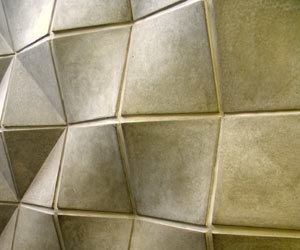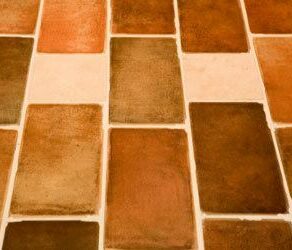
Blayne asked: How can I whiten tile grout that is stained from dust and debris within the pores of the grout? I recently had bathroom tile laid, but it has not yet been sealed. Other work done in the bathroom has caused dirt and dust to stain the grout and fill in between the small pores. The tiles and grout are all (supposed to be) white. How do I make my new tile grout look new and bright white?
Grout is porous, meaning that it is filled with tiny holes. These holes quickly collect dirt and grime, which affects the color. If the grout is not sealed, this happens fast. Even mopping will discolor unsealed grout. The rough and porous surface scrapes the dirt off of the mop and stores it in the tiny holes. In order to remove this dirt, it needs to be loosened and then extracted.
You Will Need:
- Vinegar
- Baking soda
- Ammonia
- Water
- Scrub brush
- Sponge
- Wet Vac
- Bucket
- Bleach
Steps to Remove the Dirt and Grime:
- Mrs. Clean offers a cleaning solution that is safe to use over and over on tile and grout. Combine ½ cup baking soda, 1/3 cup vinegar, ¼ cup ammonia and 7 cups of water in a bucket.
- Pour some of the solution into a spray bottle.
- Spray the solution onto the soiled grout.
- Remove it by wiping the area with a soft cloth or sponge.
- For heavily soiled grout, pour the solution onto the surface and scrub with a scrub brush.
- Vacuum the dirty solution away with a wet vac.
- Allow the area to dry completely.
- Apply the sealant following the manufacturer’s instructions.
- If the dirt is not removed, bleach can also be utilized to cut through the grime.
- The bleach can be used straight out of the bottle or mixed with water. Do NOT mix bleach into the above solution. Mixing bleach and ammonia results in dangerous fumes.
- Allow the bleach to set on the grout for a few minutes before rinsing with water.
- Vacuum all moisture away to pull the dirt out of the grout pores.
Additional Tips and Ideas:
- Steam extraction cleaning is the best way to loosen and remove dirt completely. The steam and detergents cut through the dirt and the vacuum pulls it out of all the tiny holes and pores. Though floor steamers can be costly, they are effective and may be rented from some rental locations. Another alternative is to have a professional complete the cleaning for you.
- Seal the grout immediately with a high quality sealant. This is the only way to really prevent it from becoming dirty again.









Thank you for the information. My boyfriend and I will be doing this this weekend.
Can the above mixture be used on colored grout?
I have grease stains from frying doughnuts. What can be used to remove those stains? Any ideas?
Carol,
Try using a toothbrush and dish soap.
You could also try the method used for concrete: covering the stain with a powder, such as baking soda, cornstarch, talcum powder or kitty litter. You could also try salt or flour, however those are not as absorbent and will require a longer time to soak. Cover the stain with a small mound of powder, cover the area with a bowl to guard against any wind and allow the powder to soak up the stain overnight. Vacuum the powder and repeat the process until the stain is fully removed.
Source: eHow – How to Remove Grease Stains from Grout
Source: HowToCleanStuff.net – How to Clean Concrete Floors
I work for a property manager, cleaning empty apartments and homes. Recently, I cleaned a tile floor and the grout started coming out, almost looked like it was dissolving with the water. I was using a nylon brush and warm water with a little Pine Sol in it. I got in a lot of trouble even though it was only about a two-inch spot that you could barely see. I was told it cost $500 to repair. I’m baffled. What could’ve happened?
Rhonda, two things come to mind. Likely either the grout in that small location was already loose and came free after soaking in the solution, which means the grout was likely cracked and had had some form of movement in the tile which caused it. Small pieces of grout if popped out and free are pretty brittle depending on the thickness of the grout joint, making it easier for it to crumble away. If it actually “disolved” as you say, then the grout wasn’t properly mixed for installation. Improper tile setting was likely the cause for the cracked/loose grout. That in itself can be one hundred different reasons that can cause it, not the above mentioned floor cleaning mixture. I would however exercise some caution on colored grout when using this mixture. Definitely don’t just dump straight bleach onto colored grout as you’ll likely ruin the color. Especially unsealed grout joints, and as the original question states this was for a newly laid tile floor and with colored grouts that are still curing, using hot water on it will likely cause the color to go whiter. Doing this on an unsealed white grout shouldn’t have any adverse effects that you would be able to detect anyway.
Our family all uses baby powder… How can I remove baby powder, that has been mopped over, instead of vacuumed up to remove, from bathroom tile? Seems by mopping it every time it is permenantly embedded in the tile & the grout. HELP!
Thanks
Is the cleaning solution of b. soda, vinegar, ammonia, & water safe to mop onto the tile as well as the grout?
Margaret,
This solution should be safe to use on tile. You can test it on a small, hidden area first to be sure it is safe for your specific tile though.
Exercise caution on newly laid tile floors. If need be, ask your tile setter when the grout will be fully cured; uncured and unsealed colored grout can be damaged by hot water and acids. The color will appear to show signs of efflorescence if it is subjected or mopped with hot water (i.e soaking). I have had customers mop newly laid floors with hot water and vinegar and cause uneven color throughout the tiled areas, resulting in removing the old grout and re-grouting. The grout has to be fully cured, which can take up to a month. You can seal the grout after a few days to make any construction dust clean up easier and without embedding/staining the grout. Sanded grouts are much easier to get dirty so some protection from the contractor or floor layer after the install can go a loooong way. Another option is, instead of using your typical portland cement-based grouts for your tile floor, to use an epoxy resin-based grout. They don’t require sealing, do not absorb water and won’t stain. The upfront price difference is very minor. You get what you pay for.
The only reason this above method of cleaning is acceptable on untinted grout is that the damage, if any, that ammonia or vinegar may cause will be in the white spectrum, so it’s highly likely that it will go unnoticed, especially if the entire floor was cleaned this way.
Be careful and try it in a small hidden spot before doing your entire floor. There are many factors at hand that could cause a headache for you; sealed/non sealed, tinted vs. untinted, new/old.
Be careful is all I’m saying.